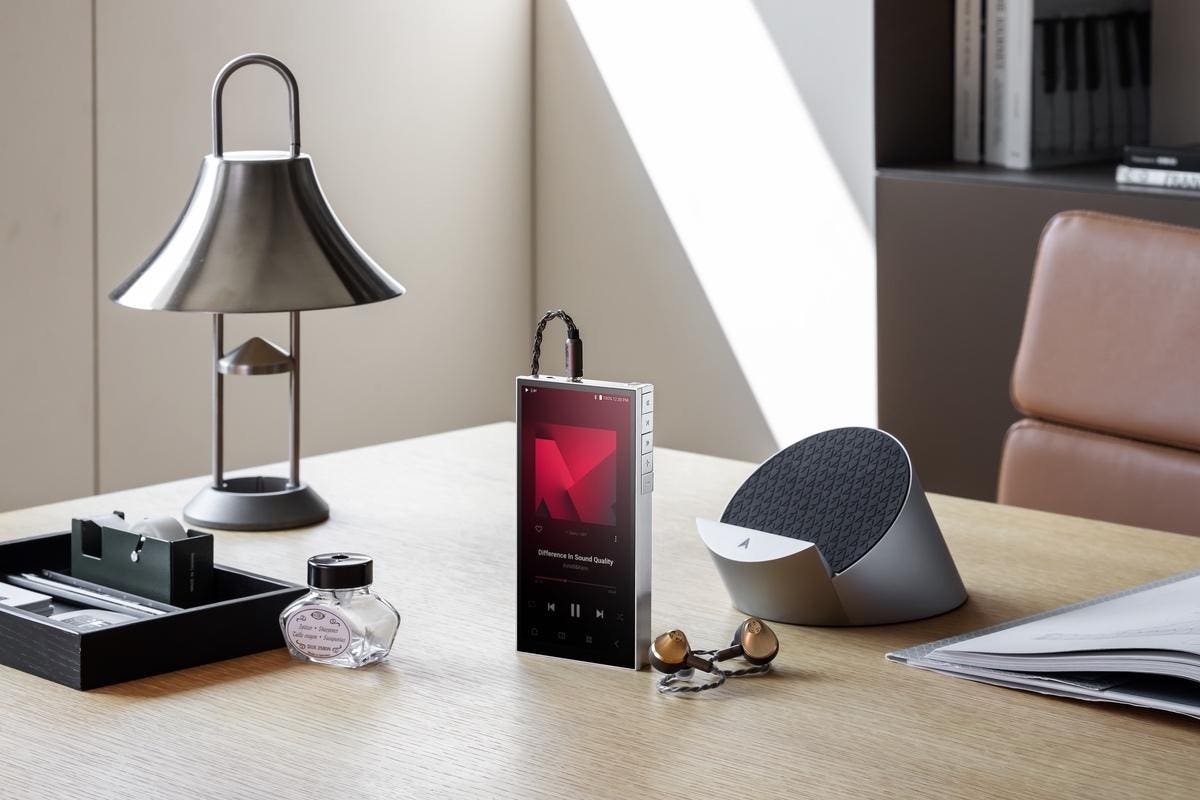The design of the PD10 is a departure from the classic angular look of Astell&Kern’s previous … More
Astell&Kern has announced the PD10, a new digital audio player designed to offer high-quality performance while still being flexible and easy to use at home or on the road. With a bold new look and several technology firsts, the new PD10 includes a docking cradle and will be available from May 2025 and priced at $2,499 / £2,499.
The new PD10 Digital Audio Player from Astell&Kern is the first product that breaks free from the constraints of the brand’s existing lineup. It’s a bold and new direction from the luxury audio brand in terms of design and innovation. The PD10 is a novel take on Astell&Kern’s iconic volume wheel design and is designed to deliver a more intuitive and distinctive experience.
New Features And Functions
The PD10 has complete Separation of the digital and analog signal paths in a HEXA-Audio circuitry structure. Astell&Kern has equipped the PD10 with the same HEXA audio circuit design first developed for the brand’s flagship SP3000 DAP. The PD10 includes four AKM AK4498EX DACs and two separate AK4191EQ chips that handle the digital signals. The PD10 is the world’s first DAP to incorporate the newly released AK4498EX chip.
The new Astell&Kern PD10 features a docking cradle for charging and playing music through an audio … More
Most digital players process digital and analog signals together inside the DAC. However, Astell&Kern’s advanced HEXA structure reduces the noise of the digital signal input through the AK4191EQ, a separate digital delta-sigma modulator. The AK4498EX DAC is designed to process the analog signals separately.
By physically and completely separating the digital and analog signal processing, Astell&Kern claims the PD10 delivers “an astonishing level of sound that has seldom been experienced before.”
Independent Dual Audio Circuits
Astell&Kern worked to overcome the limitations of sound by designing an independent dual audio circuit for unbalanced and balanced outputs. Most other DAPs use the same internal DAC for both unbalanced and balanced outputs. Since the signal from the DAC is divided into unbalanced and balanced, then delivered to the AMP, an Audio Switch is essential.
Astell&Kern says that when using a switch, there is a limit to the range of signal sent by the DAC, so most DAPs reduce the signal size first. This causes a limitation in improving the audio performance. By creating two separate audio circuits, one for balanced output and a second for unbalanced output, the company says it can maximize the audio performance no matter what output is being used.
The new Astell&Kern PD10 has buttons instead of the wheel that the brand has used in the past.
To cater to a diverse range of listening environments, the PD10 is equipped with two distinct amplifiers. Different sound tunings have been applied to each amp, taking into consideration the average impedance of connected earphones and headphones.
The Normal Gain AMP reproduces delicate details and delivers high-purity sound, faithfully reproducing the original sound. The High Gain AMP takes care of complex and dynamic sounds, rendering audio signals with greater clarity for a more immersive listening experience. By incorporating two distinct amplifiers in a single player, users can tailor the sound based on the earphones and headphones used.
Automatic Amplifier Matching Mode
The moment a headphone or earphone is connected to the PD10, the player instantly checks the impedance of the connected device and automatically sets the appropriate amp. Regardless of which earphones or headphones are connected, the PD10 automatically distinguishes between low and high impedance and then matches it with the optimal amp, without the user having to worry about manually changing settings to find the optimal match.
The Bluetooth and AIrPlay functions on the Astell&Kern PD10 make it ideal for use with powered … More
Earphones with an impedance of 32Ω or less are set to Normal Gain, providing a maximum output of 5.5Vrms when connected to the balanced output. When the earphones are greater than 32Ω they are set to High Gain, providing sufficient output of up to 8.3Vrms for balanced out. The Smart Gain function optimizes amplifier matching, providing audio enthusiasts with a large collection of different headphones and earphones with a unique and refined listening experience.
The PD10’s Crossfeed settings offer benefits for headphone users. In a headphone environment in which the left and right channels are separated, ears may become fatigued during prolonged listening.
The Crossfeed setting in the PD10 mixes parts of the original signal from one channel and sends that signal to the opposite channel with a time difference to center the sound image. Astell&Kern says the effect provides the headphone user with a sound profile like listening to the same music track in a room with full-sized speakers. Using detailed settings such as Shelf Cutoff, Shelf Gain and Mixer Level, the user can set the level of crossfeed according to their listening preferences.
The new PD10 from Astell&Kern has a bold new look that is a dramatic departure for the Korean audio … More
The Cradle That Rocks
With the included cradle, the PD10 is not only a portable device, but can also be used as a home audio source. Simultaneous device charging and digital signal input via the USB port is supported when the PD10 is mounted in the cradle. The XLR balanced outputs on the back of the cradle enable connection to a two-channel home audio system or directly to a pair of powered speakers.
XLR output levels can be controlled using the PD10’s volume controls or set at a fixed output level by enabling the line-out option in settings. An LED on the front of the cradle displays color-coded bit-rate information of the track that’s currently playing.
For the first time in an Astell&Kern player, the volume wheel has been replaced with buttons, creating a cleaner and more minimalist look while drawing the user’s attention to the control buttons. The PD10’s crafted design and production process enhances the unique colors of the materials used to make the PD10.
Pricing and Availability:
The Astell&Kern PD10 with docking cradle will be available from May 2025 at Astell&Kern dealers worldwide, including Amazon. The suggested retail price will be $2,499 / £2,499.
Features and Tech Specs:
- Native playback of high-res PCM music up to 32-bit, 768kHz and DSD512.
- Memory: 256GB of internal memory with support for microSD cards up to 2TB.
- Output: USB digital audio output, USB-C for data transfer and charging, and the ability to use the PD10 as an external DAC via Bluetooth or a direct USB connection to a Mac or Windows-based PC.
- Wi-Fi: Dual-band 2.4/5Ghz a/b/g/n/ac.
- DLNA networking: Yes.
- Display: 6-inch Full HD (1080×2160) touchscreen.
- Indicators: An LED ring around the power button provides information on the bitrate of the currently playing track.
- ReplayGain automatically and uniformly adjusts playback volume across different music tracks.
- Using AK File Drop, users can freely transfer files wirelessly through a PC, smartphone, or FTP program located on the same network.
- Music file management is now possible with a cableless, wireless solution.
- AirPlay support allows users to share music and provide direct control from Apple devices.
- Codecs: aptX HD, LHDC and LDAC codecs to provide audiophiles with multiple options for 24-bit audio playback wirelessly.
- Roon Ready: Yes.
- Bluetooth version: 5.3.
- BT Sink allows the PD10 to connect to an external device via Bluetooth and functions as a Bluetooth DAC.
- Power Delivery: 3.0 (PD 3.0).
- Battery: 5,770mAh.
- Playback time: Up to 15 hours of continuous playback.








